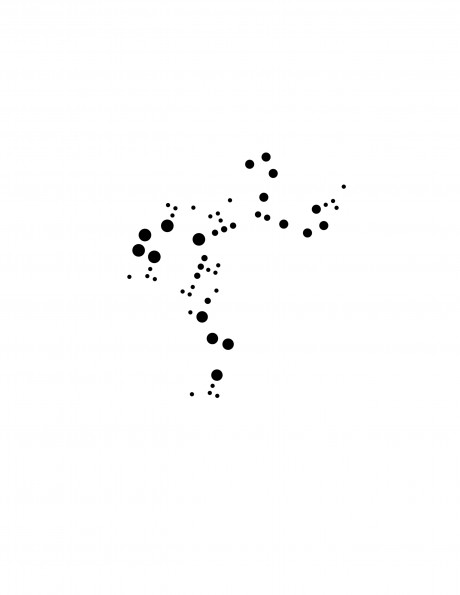Four Visual Poems
Statements on Images
In 1941, science fiction writer Robert A. Heinlein published And He Built a Crooked House. The story’s premise lies in the protagonist’s utilization of mathematics to create a tesseract-like living space, one in which, after the space folds in on itself due to an earthquake, staircases form closed loops, doorways lead to other rooms not possible mathematically, and windows that look out to various unknown, and unusual, topographical locations. The images "HbCh 4" and "HbCh 6" are algorithmic translations of two pages from Heinlein’s short story. Algorithmic translation illustrates a genre of visual poetry that utilizes the mathematical functionality found in graphic imaging software to add an element of dimensionality to a textual work by mutating the text into a kind of graphic, nonlinear entity. Through a series of algorithmic calculations, the computer program expels an abstract image based upon the original topographical placement of the type on the space of the page. This algorithm transforms each letter, each mark of punctuation, into dendrites that fold in on themselves and propagate through a vastitude that lies beyond what viewers perceive as a two-dimensional page.
"cys 2" illustrates the molecular structure for the sulfur-containing amino acid cysteine, but rendered in braille. The human body produces cysteine, a non-essential amino acid, though biosynthesis;however, this synthesis cannot take place without methionine, an essential amino acid and key ingredient that the body must obtain from outside methionine-containing proteins. Through a series of transmutations, Methionine is first converted in the liver to Sadenosylmethionine, which is then converted to homocysteine. Homocysteine then reacts with the amino acid serine to form cysteine. When taken in a synthetic N-acetyl cysteine form, a derivative in which an acetyl group has been bonded to the molecular structure, cysteine increases the production of glutathione, an antioxidant, which, as studies have shown, helps in the prevention of cataracts, glaucoma, retinal disorders, and macular degeneration - or, diseases that cause blindness. We have the ability to delineate the structures of organic compounds, and we have the ability to manipulate elements to create the structures of synthetic compounds; however, we lack the technological ability to see each individual atom that creates these molecular compositions, which is why cys 2 has been reconstructed in braille. Braille is a code for the blind; yet, by reconstructing the molecular structure for cysteine in braille, the viewer has the opportunity to touch this lattice with their eyes.
"Shrapnel #4: Raunchy Phone Sex (Obama has Failed)" represents a visual deconstruction of the New York Times’ Aug 30, 2012 homepage. The image’s title derives from the fusion of two surviving, yet fragmented, grammatical units that stem from two different articles found within the homepage after the entirety of the homepage text sustained a randomized process of textual eradication. Although these two fragmented units have not technically fused within the image itself, they now share the same space free, unbounded, from the constraints of articles, article boundaries, advertisements, and all other media discourses (due to the eradication process). This cohabitation within a new textual framework suggests that the discourses that surround human sexuality (raunchy phone sex) and the discourses that surround political rhetoric (Obama has failed) share threads of similitude.



